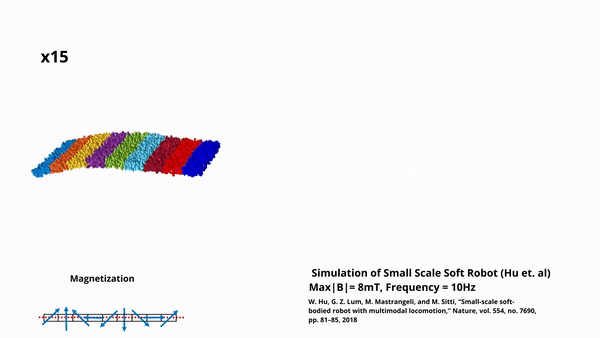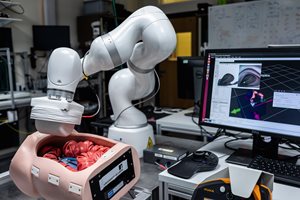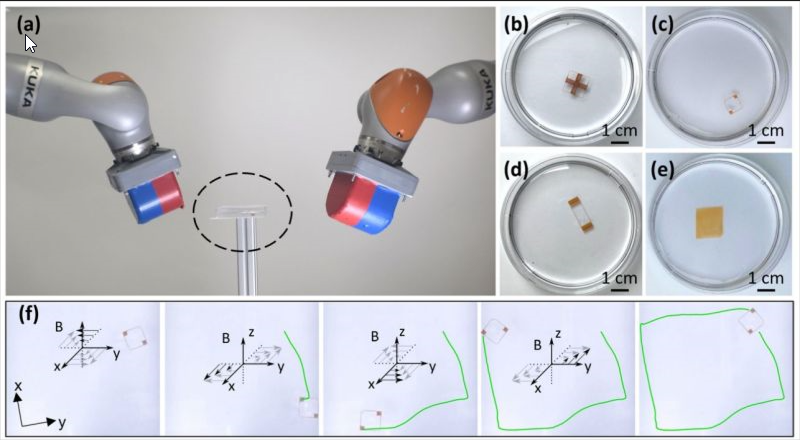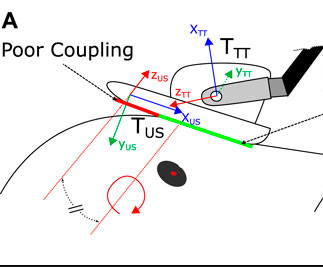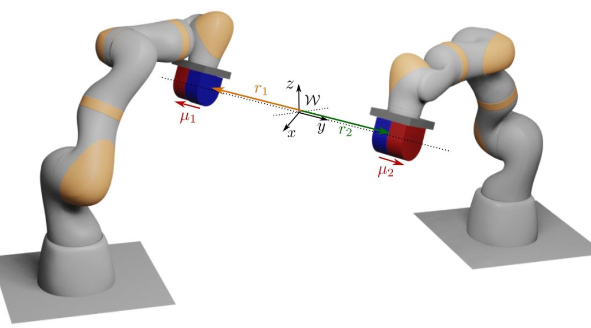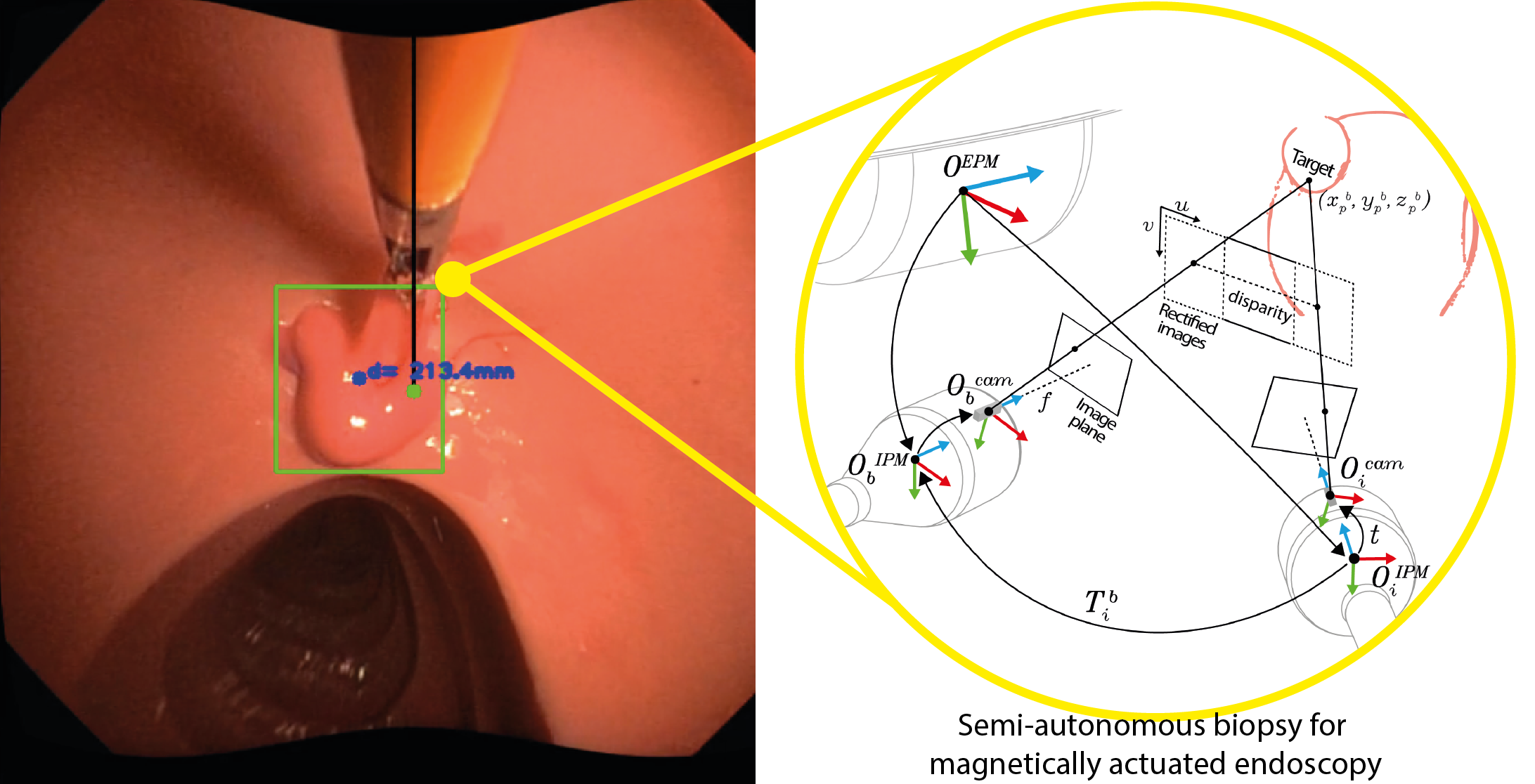In this collaborative paper with Prof Simaan’s group at Vanderbilt University, we explore for the first time how to implement full-shape closed loop control of a magnetic tentacle robot using fiber Bragg grating sensors. We demonstrate that the proposed controller, running at approximately 300 Hz, is capable of shape tracking with a mean error of […]
A Framework for Simulation of Magnetic Soft Robots using the Material Point Method
In this work, we developed a simulation framework for magnetic soft robots using the Material Point Method (MPM). This framework can accurately model robot behaviour under external magnetic fields, including the complexities of material elasticity and magnetic wrench. The framework can accurately model the self-collision of robots and dynamic response under time-varying fields. We validate this […]
STORMLAB featured in Royal Academy of Engineering Ingenia Magazine
We are thrilled to announce that our work on magnetically guided colonoscopy has been featured in the March 2023 issue of Ingenia Magazine, published by the Royal Academy of Engineering. The innovative instrument developed by our research team at the STORM Laboratory, University of Leeds, uses intelligent and autonomous magnetic manipulation to make colonoscopies more […]
Micro-scale aerosol jet printing of superparamagnetic Fe3O4 nanoparticle patterns
Creating custom patterns of magnetic nanoparticles on flexible substrates may enable new opportunities in early diagnosis and personalised treatment of life-threatening diseases. In this collaboration led by the Future Manufacturing Processes Research Group at the University of Leeds, we demonstrated for the first time that Aerosol Jet Printing can be leveraged to reliably print large-area, […]
Towards Autonomous Robotic Minimally Invasive Ultrasound Scanning and Vessel Reconstruction on Non-Planar Surfaces
In our recently published work, we explore the challenges and a potential solution for enabling autonomous intracorporeal Ultrasound (US) scanning during robotic surgery. Enabled by a novel kinematic sensor-fusion scheme, we demonstrate the autonomous navigation and probe reorientation along a phantom hepatic vessel structure. Check out our paper for in-depth results and future directions of […]
Collaborative Magnetic Manipulation via Two Robotically Actuated Permanent Magnets
What happens if you place two large magnets at the end effector of two serial robots? How many independent degrees of freedom can be magnetically controlled in the central workspace? We have explored these and other research questions in our latest IEEE Transactions on Robotics paper that introduces the dual External Permanent Magnet (dEPM) platform. […]
Gordon Research Seminar presentation and the Gordon Research Conference
Michael and Giovanni had the privilege and pleasure to present their work at the first ever Gordon Research Seminar (GRS) on Robotics last week. While Professor Valdastri presented a summary of the progress made by the Tentacles project at the Gordon Research Conference (GRC). Professor Valdastri summarized the event by saying “Cutting edge research shared […]
‘Robotic Autonomy for Magnetic Endoscope Biopsy
The magnetic flexible endoscope team have just published their latest work entitled ‘Robotic Autonomy for Magnetic Endoscope Biopsy’ to IEEE Transactions on Medical Robotics and Bionics. Tissue biopsies taken during colonoscopy are important to aid in the early detection of diseases such as colorectal cancer, Crohn’s and Ulcerated Colitis. Using our magnetic endoscope, developed to […]
A decade retrospective of medical robotics research from 2010 to 2020
Together with world-leading experts in medical robotics, we have prepared a concise review of the progresses in the last decade that is now published in Science Robotics. This paper is a great read for newcomers to the field as well as for more established researchers. You can find the paper at this link: https://www.science.org/doi/10.1126/scirobotics.abi8017
A Comparative Study of Spatio-Temporal U-Nets for Tissue Segmentation in Surgical Robotics
This paper compares the performance of three different neural network structures based on the U-Net for tissue segmentation. The models subject of this study comprise temporal layers such as Long Short Term Memory cells and Attention Gate block. Results show that the model benefits from the implementation of temporal layers along with attention-based layers, even […]


